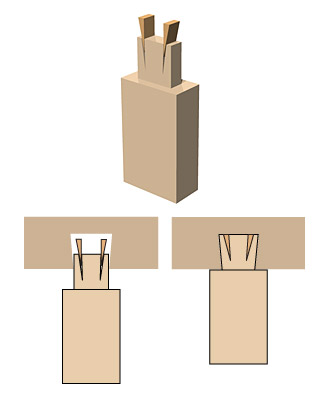|
||
 |
||

(C)2001 Japanese Architecture and Art Net Users System. No reproduction or republication without written permission.
掲載のテキスト・写真・イラストなど、全てのコンテンツの無断複製・転載を禁じます。
|
||||||
| jigokuhozo 地獄ほぞ | ||||||
| KEY WORD : architecture / joints | ||||||
| Lit.
hell tenon. So named because once it is inserted, it is impossible to withdraw.
A blind tenon joint with wedges *kusabi
楔 inserted tightly into slots made on its end. It is important first to
place the wedges loosely into the slots to inhibit premature horizontal
spreading of the tenon. The base of the tenon is large enough to fit the
dovetail-like, tapered shape of the mortise *hozoana
ほぞ穴. When the tenon with wedges is pounded into the mortise, the wedges
cause the tenon to expand to fit the sides of the mortise. Only the wedges
extend the depth of the mortise. The tenon itself does not. Wedges may also
be placed on each side of the tenon. The jigokuhozo joint is used
where it is necessary that it be hidden, for example on bracket complexes
under the eaves of a building, in furniture and cabinet making, and especially
in joinery used in the shoin style *shoin-zukuri
書院造. |
||||||
| |
||||||
 |
||||||
| REFERENCES: | ||||||
| EXTERNAL LINKS: | ||||||
| NOTES: | ||||||
(C)2001 Japanese Architecture and Art Net Users System. No reproduction or republication without written permission. 掲載のテキスト・写真・イラストなど、全てのコンテンツの無断複製・転載を禁じます。 |
||||||